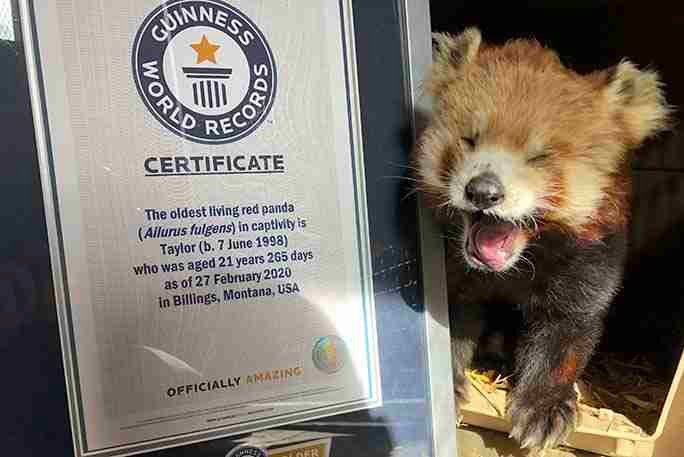Learning about your favorite creatures should never stop. And as a red panda fan, do you have any idea how long they live?
It’s okay if you don’t. This article will provide all your answers to your questions relating to red pandas’ lifespan.
What is the Average Lifespan of Red Pandas?
In the Wild
Scientists have been finding it difficult to determine the lifespan of wild red pandas. However, based on estimates, they’re expected to live about 8–10 years.
This is shorter compared to their lifespan in captivity. Living in the wild is not as favorable as living under human care in captivity.
Red pandas face a lot of threats and unfavorable conditions in the wild that shorten their lifespan.
In Captivity
They can live for up to 10–15 years in captivity. They can live longer than this—up to 20 years, depending on favorable factors like the environment, breed, etc.
Red pandas start to show signs of aging when they are about 12–14 years old. By the time they are 8 months old, red pandas reach sexual maturity.
4 Factors That Affect the Lifespan of Red Pandas
Diet
Bamboo is a major food source for red pandas living both in the wild and in captivity. And this is a diet that contains very few nutrients.
For this reason, they eat so much in a day just to meet their daily nutritional needs. Well, their diet is the same in captivity, but better!
Zookeepers feed captive red pandas other nutritious foods—fruits, veggies, leaf-eater biscuits, etc. This way, they can get the important nutrients they don’t get from eating bamboo alone.
No doubt, a diet like this makes captive pandas more healthy than those living in the wild. Furthermore, it allows them to live longer.
Environmental Factors
The habitat of red pandas is cool, wet forests. This is a kind of temperature and environment that suits them.
However, in the wild, there can be sudden temperature changes and climatic conditions. And this makes a living very uncomfortable for these creatures.
Zoos and conservation centers try as much as possible to copy the red panda’s natural living environment. They protect the captive red pandas from uncomfortable climate and temperature changes.
With such an environment, captive red pandas are bound to survive more than wild ones.
Threats
Living in the wild can be challenging for red pandas due to the many threats. If you compare this to life in captivity, red pandas living in zoos are just living in paradise.
What endangers red pandas the most in the wild is habitat destruction.
These creatures shelter only in trees. Hence, it’s difficult for them to survive for long without good shelter. In addition, red pandas are prey for hunters and poachers.
Sometimes they are killed or even injured. Whichever way, all these threats reduce the red pandas’ chances of living longer in the wild.
In captivity, red pandas do not need to worry about habitat loss, hunters, or any other threat. And no doubt, these good living condition provided for them can boost their lifespan.
Genetics
Hereditary factors such as disease resistance and longevity genes greatly determine how long animals can live. Red pandas are no exception.
Some red pandas might have genes that make them live longer than others. What’s more, these genes are hereditary. They are passed down from parents to children and generations.
It’s more likely that a red panda will have a long lifespan if both of its parents have these genes.
How Old is the World’s Oldest Red Panda?

Taylor, a male red panda that lived in ZooMontana, still holds the record for the world’s oldest red panda to date.
His age was confirmed to be 21 years and 265 days when he died. Only a few red pandas in captivity have gotten close to this age.
Frequently Asked Questions:
How Long Do Red Pandas Live With Their Mothers?
Young red pandas only live up to one year with their mothers. This is around the age when they’re fully grown.
Some red pandas will keep living with their mothers. Probably when their mothers become pregnant again, or until they have another child.
How Long Can Red Pandas Live Without Bamboo?

Red pandas, both captive and wild, can’t live for long without bamboo because it’s their main food.
In other words, bamboo is the only food they can survive on. And they need to keep eating it steadily due to the low nutrients it offers.
This equally makes eating bamboo a major daily activity for these creatures. They only take short breaks from eating bamboo
Interestingly, red pandas are originally carnivores that can eat meat. They still eat meat, but occasionally.
A red panda’s diet is a matter of choice. And red pandas will choose bamboo over anything.
Recap:
To sum up, red pandas live about 8–10 years in the wild and 10–15 years in captivity. In addition, they do not show signs of age early.
Above all, here are a few things to remember:
- Red pandas live longer in Captivity. There, they can reach up to 20 years.
- Red pandas living in better environments tend to live longer.
- The threats these creatures face in the wild not only endanger them but also shorten their lifespan.
- Many red pandas carry genes that contribute to longer lifespans.
- Young red pandas live up to a year with their mothers.
- Taylor, the red panda who lived in ZooMontana, is the world’s oldest red panda (Age: 21 years, 265 days).
- Red pandas survive mostly on bamboo and cannot live for long without it.
Now you’ve learned about the lifespan of the lesser pandas. And it might interest you to know about giant pandas’ lifespan too.
Do giant pandas have shorter or longer lifespans than red pandas?
Find all your answers in our article – How long Do Giant Pandas Live?

